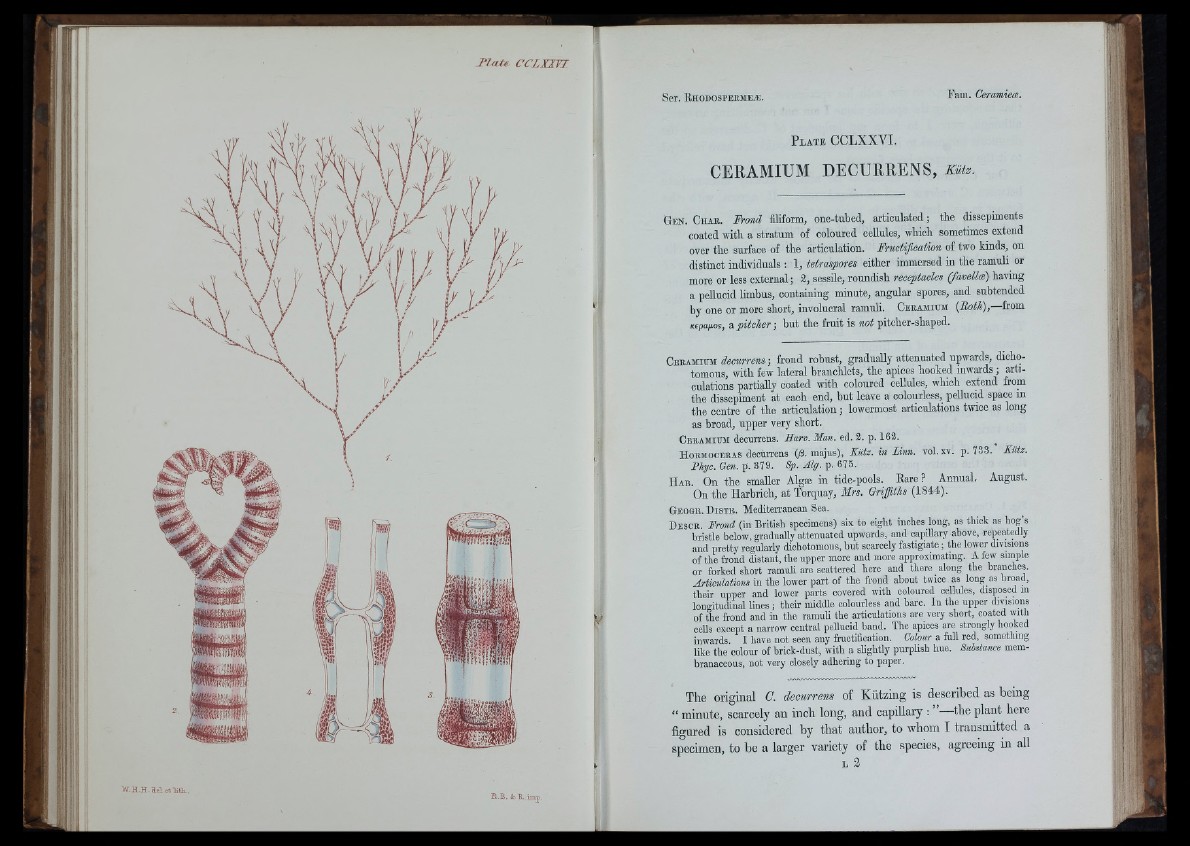
P l a t e CCLXXVI.
CERAMIUM DECURRENS, Kütz.
Gen. C h a e . Frond filiform, o n e -tu b ed , a rtic u la te d ; tb e dissepiments
co ated w ith a s tra tum o f colo u red cellules, w hich sometimes ex ten d
over th e surface of th e a rtic u la tio n . Fructification of two k in d s , on
d is tin c t in d iv id u a ls : 1, tetraspores e ith e r immersed in th e ram u h or
more or less e x te rn a l; 2, sessile, ro u n d ish receptacles (favelloe) h av in g
a p e llu c id lim b u s, co n ta in in g m in u te , a n g u la r spores, a n d su b ten d ed
by one or m o re sh o rt, in v o lu c ra l ram u li. C ee am itjm {Both),— from
Kspapos, a p itcher ; b u t th e fr u it is m t p itch e r-sh a p ed .
Ceeamium frond robust, gradually attenuated upwards, dichotomous,
with few lateral branchlets, the apices hooked inwards ; arti-
culations partially coated with coloured cellules, which extend from
the dissepiment at each end, but leave a colourless, pellucid space in
the centre of the articulation ; lowermost articulations twice as long
as broad, upper very short.
Cekamium decurrens. Harv. Man. ed. 2. p. 162.
H okmoceras decurrens O. majus), Kütz. in Linn, vol.xv. p. 783. Kutz.
Phyc. Gen. % rfi/. p. 675.
H ab. On th e smaller Algæ in tide-pools. Bare? Annual. August.
On the Harbrioh, at Torquay, Mrs. Griffiths (1844).
Geogr. D is t b . Mediterranean Sea.
D esc r. Frond (in British specimens) six to eight inches long, as thick as hog’s
bristle below, gradually attenuated upwards, and capillary above, repeatedly
and pretty regularly dichotomous, but scarcely fastigiate ; the lower divisions
of the frond distant, the upper more and more approximating. A few simple
or forked short ramuh are scattered here and there along the branches.
Articulations in the lower part of the frond about twice as long as broad,
their upper and lower parts covered with coloured cellules, disposed in
lono-itudinal lines ; their middle colourless and bai'e. In the upper divisions
of the frond and in the ramuli the articulations are very short, coated with
eeUs except a narrow central peUucid band. The apices are strongly hooked
inwards I have not seen any fructification. Colour a full red, something
like the colour of brick-dust, with a slightly purplish hue. Substance membranaceous,
not very closely adhering to paper.
The original C. decurrens of Kützing is described as being
“ minute, scarcely an inch long, and capillary : the plant here
figured is considered by that author, to whom I transmitted a
specimen, to be a larger variety of the species, agreeing in all
L 2
I: ill